Understanding and Leading Change
VerifiedAdded on 2023/01/18
|14
|4739
|88
AI Summary
Contribute Materials
Your contribution can guide someone’s learning journey. Share your
documents today.
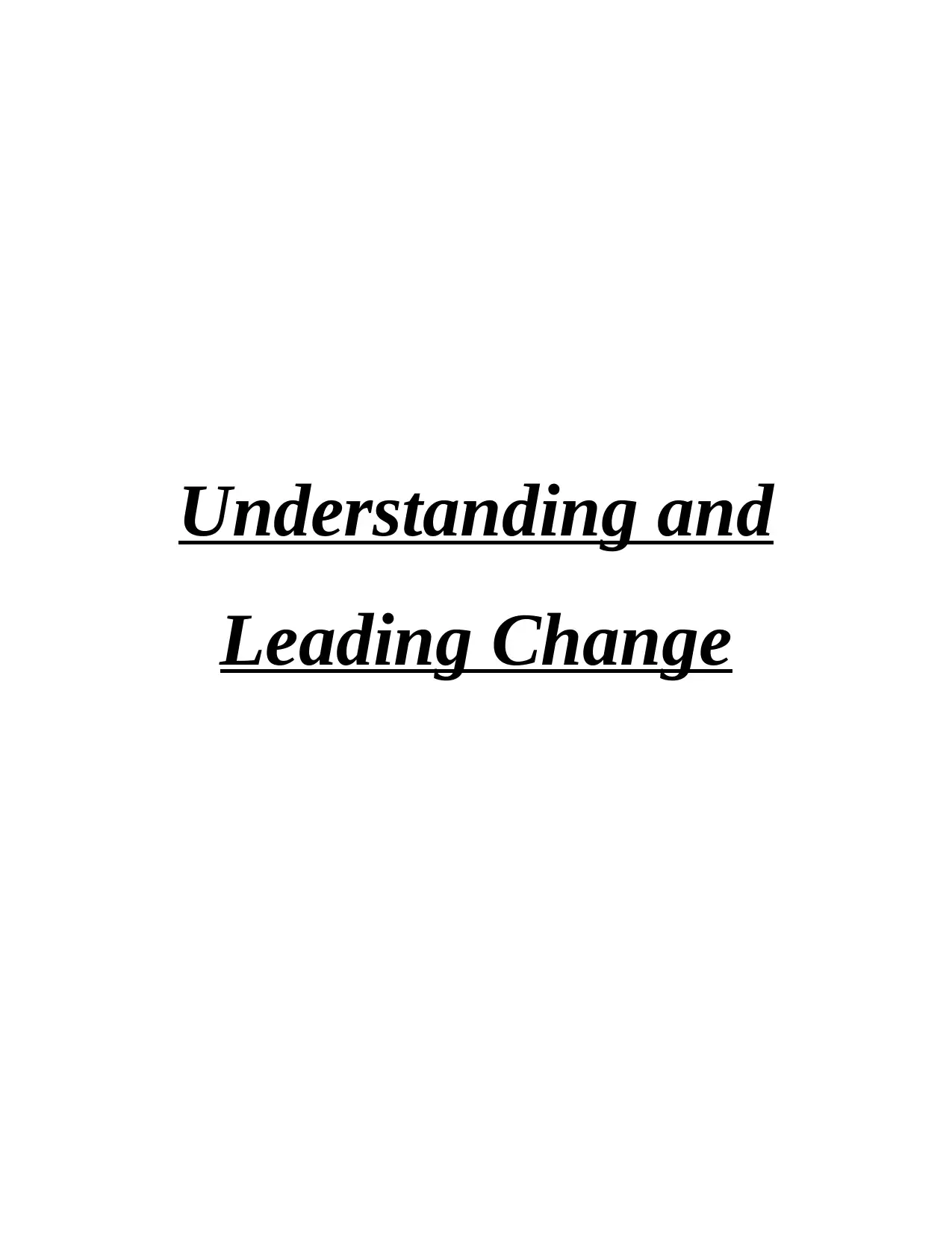
Understanding and
Leading Change
Leading Change
Secure Best Marks with AI Grader
Need help grading? Try our AI Grader for instant feedback on your assignments.
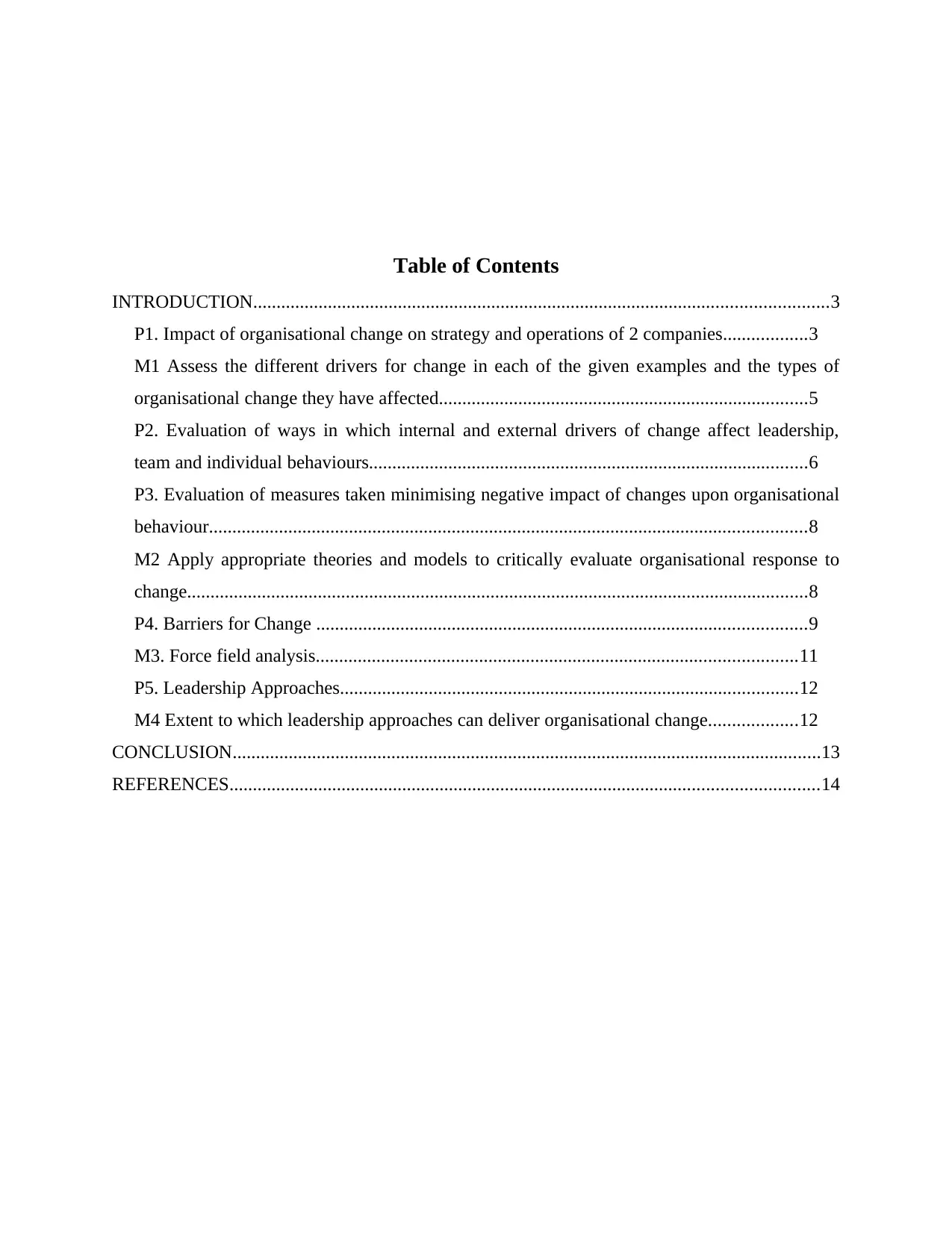
Table of Contents
INTRODUCTION...........................................................................................................................3
P1. Impact of organisational change on strategy and operations of 2 companies..................3
M1 Assess the different drivers for change in each of the given examples and the types of
organisational change they have affected...............................................................................5
P2. Evaluation of ways in which internal and external drivers of change affect leadership,
team and individual behaviours..............................................................................................6
P3. Evaluation of measures taken minimising negative impact of changes upon organisational
behaviour................................................................................................................................8
M2 Apply appropriate theories and models to critically evaluate organisational response to
change.....................................................................................................................................8
P4. Barriers for Change .........................................................................................................9
M3. Force field analysis.......................................................................................................11
P5. Leadership Approaches..................................................................................................12
M4 Extent to which leadership approaches can deliver organisational change...................12
CONCLUSION..............................................................................................................................13
REFERENCES..............................................................................................................................14
INTRODUCTION...........................................................................................................................3
P1. Impact of organisational change on strategy and operations of 2 companies..................3
M1 Assess the different drivers for change in each of the given examples and the types of
organisational change they have affected...............................................................................5
P2. Evaluation of ways in which internal and external drivers of change affect leadership,
team and individual behaviours..............................................................................................6
P3. Evaluation of measures taken minimising negative impact of changes upon organisational
behaviour................................................................................................................................8
M2 Apply appropriate theories and models to critically evaluate organisational response to
change.....................................................................................................................................8
P4. Barriers for Change .........................................................................................................9
M3. Force field analysis.......................................................................................................11
P5. Leadership Approaches..................................................................................................12
M4 Extent to which leadership approaches can deliver organisational change...................12
CONCLUSION..............................................................................................................................13
REFERENCES..............................................................................................................................14
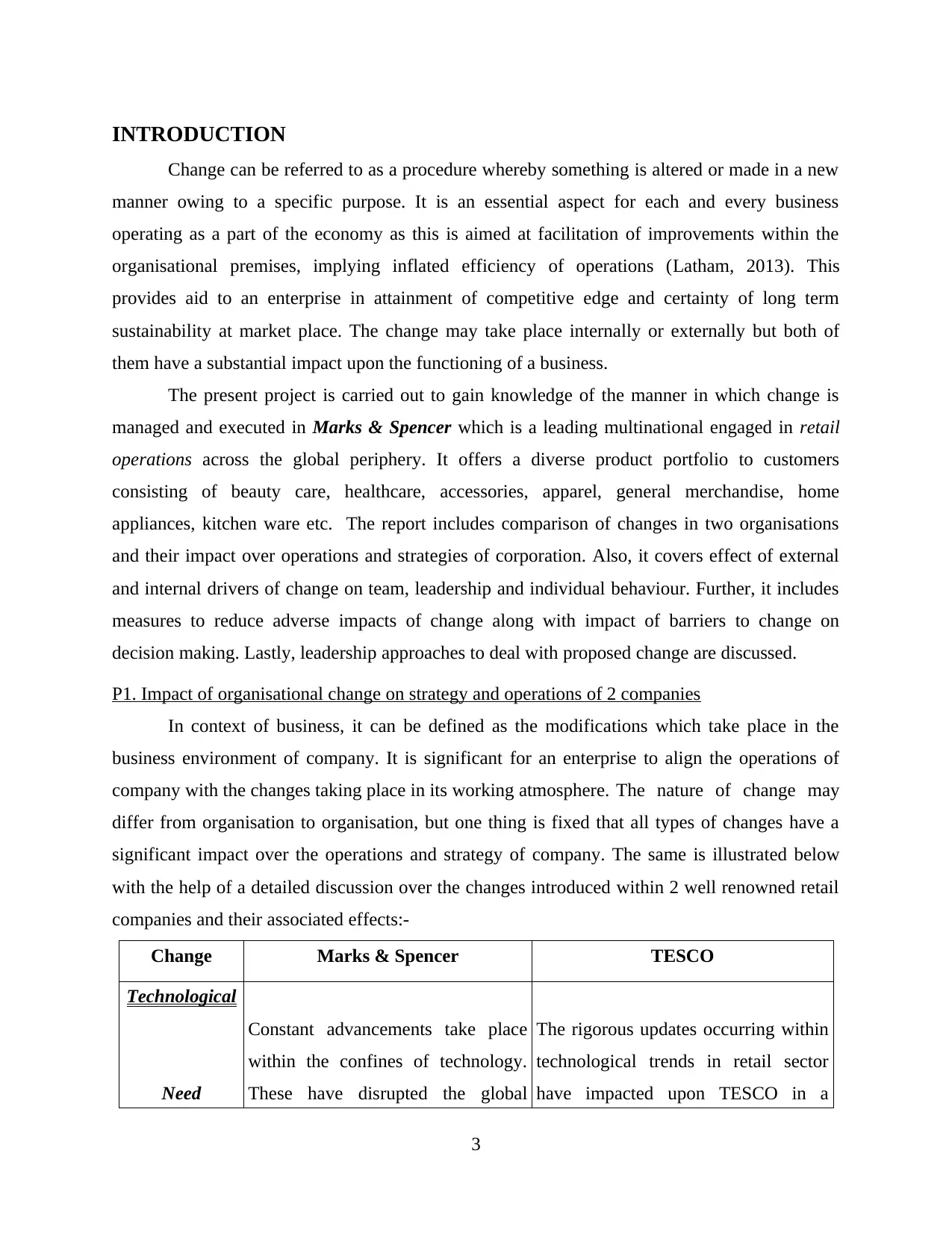
INTRODUCTION
Change can be referred to as a procedure whereby something is altered or made in a new
manner owing to a specific purpose. It is an essential aspect for each and every business
operating as a part of the economy as this is aimed at facilitation of improvements within the
organisational premises, implying inflated efficiency of operations (Latham, 2013). This
provides aid to an enterprise in attainment of competitive edge and certainty of long term
sustainability at market place. The change may take place internally or externally but both of
them have a substantial impact upon the functioning of a business.
The present project is carried out to gain knowledge of the manner in which change is
managed and executed in Marks & Spencer which is a leading multinational engaged in retail
operations across the global periphery. It offers a diverse product portfolio to customers
consisting of beauty care, healthcare, accessories, apparel, general merchandise, home
appliances, kitchen ware etc. The report includes comparison of changes in two organisations
and their impact over operations and strategies of corporation. Also, it covers effect of external
and internal drivers of change on team, leadership and individual behaviour. Further, it includes
measures to reduce adverse impacts of change along with impact of barriers to change on
decision making. Lastly, leadership approaches to deal with proposed change are discussed.
P1. Impact of organisational change on strategy and operations of 2 companies
In context of business, it can be defined as the modifications which take place in the
business environment of company. It is significant for an enterprise to align the operations of
company with the changes taking place in its working atmosphere. The nature of change may
differ from organisation to organisation, but one thing is fixed that all types of changes have a
significant impact over the operations and strategy of company. The same is illustrated below
with the help of a detailed discussion over the changes introduced within 2 well renowned retail
companies and their associated effects:-
Change Marks & Spencer TESCO
Technological
Need
Constant advancements take place
within the confines of technology.
These have disrupted the global
The rigorous updates occurring within
technological trends in retail sector
have impacted upon TESCO in a
3
Change can be referred to as a procedure whereby something is altered or made in a new
manner owing to a specific purpose. It is an essential aspect for each and every business
operating as a part of the economy as this is aimed at facilitation of improvements within the
organisational premises, implying inflated efficiency of operations (Latham, 2013). This
provides aid to an enterprise in attainment of competitive edge and certainty of long term
sustainability at market place. The change may take place internally or externally but both of
them have a substantial impact upon the functioning of a business.
The present project is carried out to gain knowledge of the manner in which change is
managed and executed in Marks & Spencer which is a leading multinational engaged in retail
operations across the global periphery. It offers a diverse product portfolio to customers
consisting of beauty care, healthcare, accessories, apparel, general merchandise, home
appliances, kitchen ware etc. The report includes comparison of changes in two organisations
and their impact over operations and strategies of corporation. Also, it covers effect of external
and internal drivers of change on team, leadership and individual behaviour. Further, it includes
measures to reduce adverse impacts of change along with impact of barriers to change on
decision making. Lastly, leadership approaches to deal with proposed change are discussed.
P1. Impact of organisational change on strategy and operations of 2 companies
In context of business, it can be defined as the modifications which take place in the
business environment of company. It is significant for an enterprise to align the operations of
company with the changes taking place in its working atmosphere. The nature of change may
differ from organisation to organisation, but one thing is fixed that all types of changes have a
significant impact over the operations and strategy of company. The same is illustrated below
with the help of a detailed discussion over the changes introduced within 2 well renowned retail
companies and their associated effects:-
Change Marks & Spencer TESCO
Technological
Need
Constant advancements take place
within the confines of technology.
These have disrupted the global
The rigorous updates occurring within
technological trends in retail sector
have impacted upon TESCO in a
3
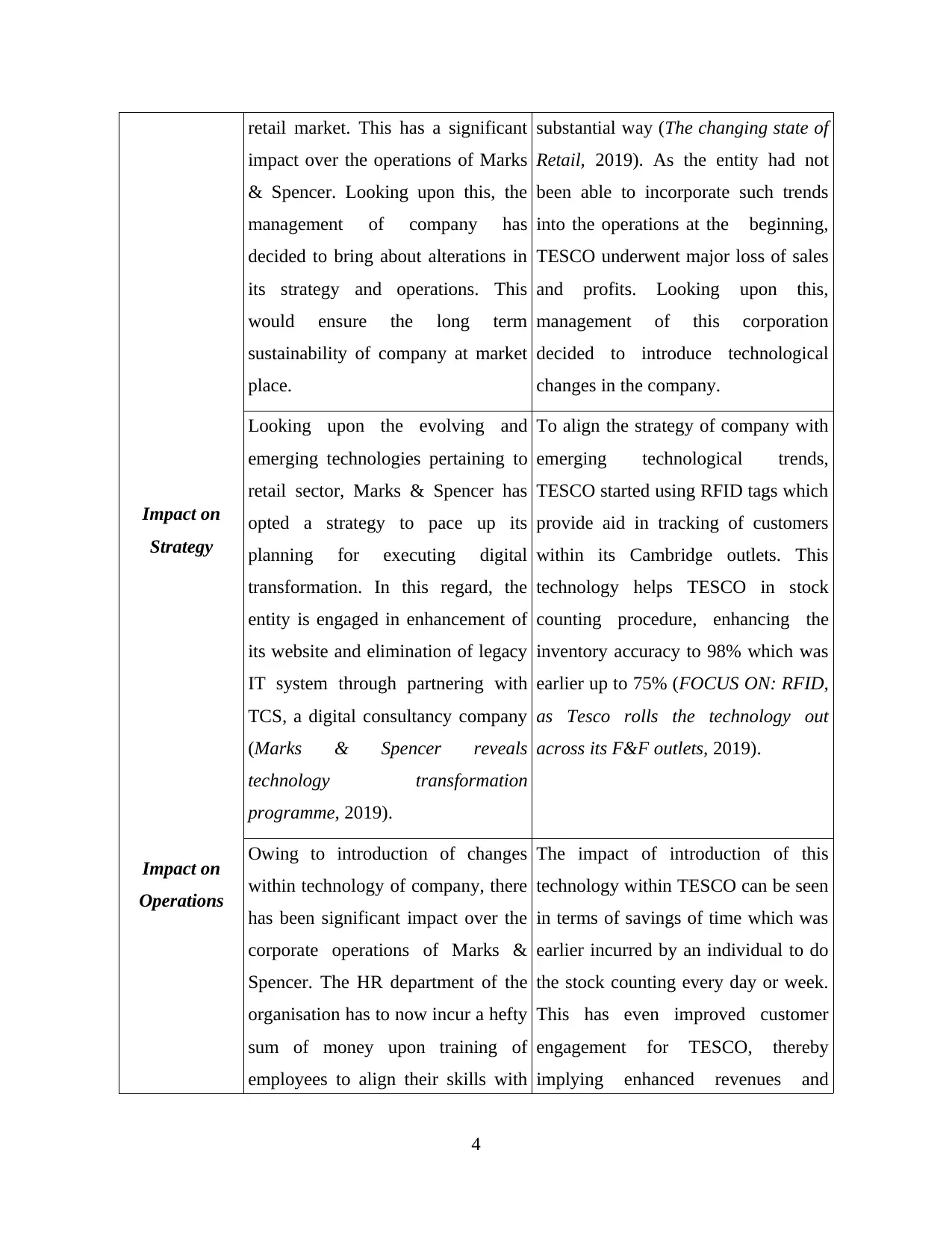
Impact on
Strategy
Impact on
Operations
retail market. This has a significant
impact over the operations of Marks
& Spencer. Looking upon this, the
management of company has
decided to bring about alterations in
its strategy and operations. This
would ensure the long term
sustainability of company at market
place.
substantial way (The changing state of
Retail, 2019). As the entity had not
been able to incorporate such trends
into the operations at the beginning,
TESCO underwent major loss of sales
and profits. Looking upon this,
management of this corporation
decided to introduce technological
changes in the company.
Looking upon the evolving and
emerging technologies pertaining to
retail sector, Marks & Spencer has
opted a strategy to pace up its
planning for executing digital
transformation. In this regard, the
entity is engaged in enhancement of
its website and elimination of legacy
IT system through partnering with
TCS, a digital consultancy company
(Marks & Spencer reveals
technology transformation
programme, 2019).
To align the strategy of company with
emerging technological trends,
TESCO started using RFID tags which
provide aid in tracking of customers
within its Cambridge outlets. This
technology helps TESCO in stock
counting procedure, enhancing the
inventory accuracy to 98% which was
earlier up to 75% (FOCUS ON: RFID,
as Tesco rolls the technology out
across its F&F outlets, 2019).
Owing to introduction of changes
within technology of company, there
has been significant impact over the
corporate operations of Marks &
Spencer. The HR department of the
organisation has to now incur a hefty
sum of money upon training of
employees to align their skills with
The impact of introduction of this
technology within TESCO can be seen
in terms of savings of time which was
earlier incurred by an individual to do
the stock counting every day or week.
This has even improved customer
engagement for TESCO, thereby
implying enhanced revenues and
4
Strategy
Impact on
Operations
retail market. This has a significant
impact over the operations of Marks
& Spencer. Looking upon this, the
management of company has
decided to bring about alterations in
its strategy and operations. This
would ensure the long term
sustainability of company at market
place.
substantial way (The changing state of
Retail, 2019). As the entity had not
been able to incorporate such trends
into the operations at the beginning,
TESCO underwent major loss of sales
and profits. Looking upon this,
management of this corporation
decided to introduce technological
changes in the company.
Looking upon the evolving and
emerging technologies pertaining to
retail sector, Marks & Spencer has
opted a strategy to pace up its
planning for executing digital
transformation. In this regard, the
entity is engaged in enhancement of
its website and elimination of legacy
IT system through partnering with
TCS, a digital consultancy company
(Marks & Spencer reveals
technology transformation
programme, 2019).
To align the strategy of company with
emerging technological trends,
TESCO started using RFID tags which
provide aid in tracking of customers
within its Cambridge outlets. This
technology helps TESCO in stock
counting procedure, enhancing the
inventory accuracy to 98% which was
earlier up to 75% (FOCUS ON: RFID,
as Tesco rolls the technology out
across its F&F outlets, 2019).
Owing to introduction of changes
within technology of company, there
has been significant impact over the
corporate operations of Marks &
Spencer. The HR department of the
organisation has to now incur a hefty
sum of money upon training of
employees to align their skills with
The impact of introduction of this
technology within TESCO can be seen
in terms of savings of time which was
earlier incurred by an individual to do
the stock counting every day or week.
This has even improved customer
engagement for TESCO, thereby
implying enhanced revenues and
4
Secure Best Marks with AI Grader
Need help grading? Try our AI Grader for instant feedback on your assignments.
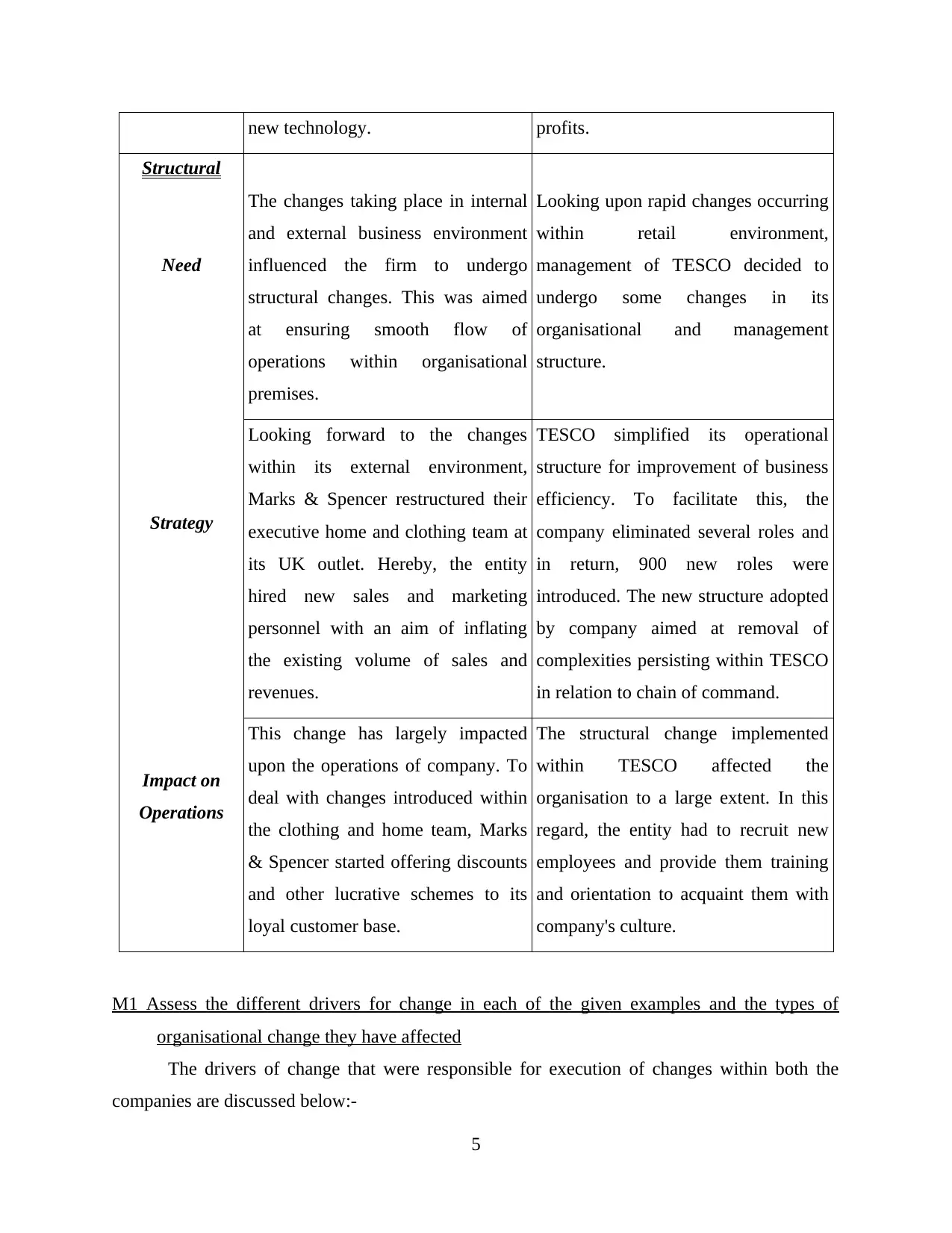
new technology. profits.
Structural
Need
Strategy
Impact on
Operations
The changes taking place in internal
and external business environment
influenced the firm to undergo
structural changes. This was aimed
at ensuring smooth flow of
operations within organisational
premises.
Looking upon rapid changes occurring
within retail environment,
management of TESCO decided to
undergo some changes in its
organisational and management
structure.
Looking forward to the changes
within its external environment,
Marks & Spencer restructured their
executive home and clothing team at
its UK outlet. Hereby, the entity
hired new sales and marketing
personnel with an aim of inflating
the existing volume of sales and
revenues.
TESCO simplified its operational
structure for improvement of business
efficiency. To facilitate this, the
company eliminated several roles and
in return, 900 new roles were
introduced. The new structure adopted
by company aimed at removal of
complexities persisting within TESCO
in relation to chain of command.
This change has largely impacted
upon the operations of company. To
deal with changes introduced within
the clothing and home team, Marks
& Spencer started offering discounts
and other lucrative schemes to its
loyal customer base.
The structural change implemented
within TESCO affected the
organisation to a large extent. In this
regard, the entity had to recruit new
employees and provide them training
and orientation to acquaint them with
company's culture.
M1 Assess the different drivers for change in each of the given examples and the types of
organisational change they have affected
The drivers of change that were responsible for execution of changes within both the
companies are discussed below:-
5
Structural
Need
Strategy
Impact on
Operations
The changes taking place in internal
and external business environment
influenced the firm to undergo
structural changes. This was aimed
at ensuring smooth flow of
operations within organisational
premises.
Looking upon rapid changes occurring
within retail environment,
management of TESCO decided to
undergo some changes in its
organisational and management
structure.
Looking forward to the changes
within its external environment,
Marks & Spencer restructured their
executive home and clothing team at
its UK outlet. Hereby, the entity
hired new sales and marketing
personnel with an aim of inflating
the existing volume of sales and
revenues.
TESCO simplified its operational
structure for improvement of business
efficiency. To facilitate this, the
company eliminated several roles and
in return, 900 new roles were
introduced. The new structure adopted
by company aimed at removal of
complexities persisting within TESCO
in relation to chain of command.
This change has largely impacted
upon the operations of company. To
deal with changes introduced within
the clothing and home team, Marks
& Spencer started offering discounts
and other lucrative schemes to its
loyal customer base.
The structural change implemented
within TESCO affected the
organisation to a large extent. In this
regard, the entity had to recruit new
employees and provide them training
and orientation to acquaint them with
company's culture.
M1 Assess the different drivers for change in each of the given examples and the types of
organisational change they have affected
The drivers of change that were responsible for execution of changes within both the
companies are discussed below:-
5
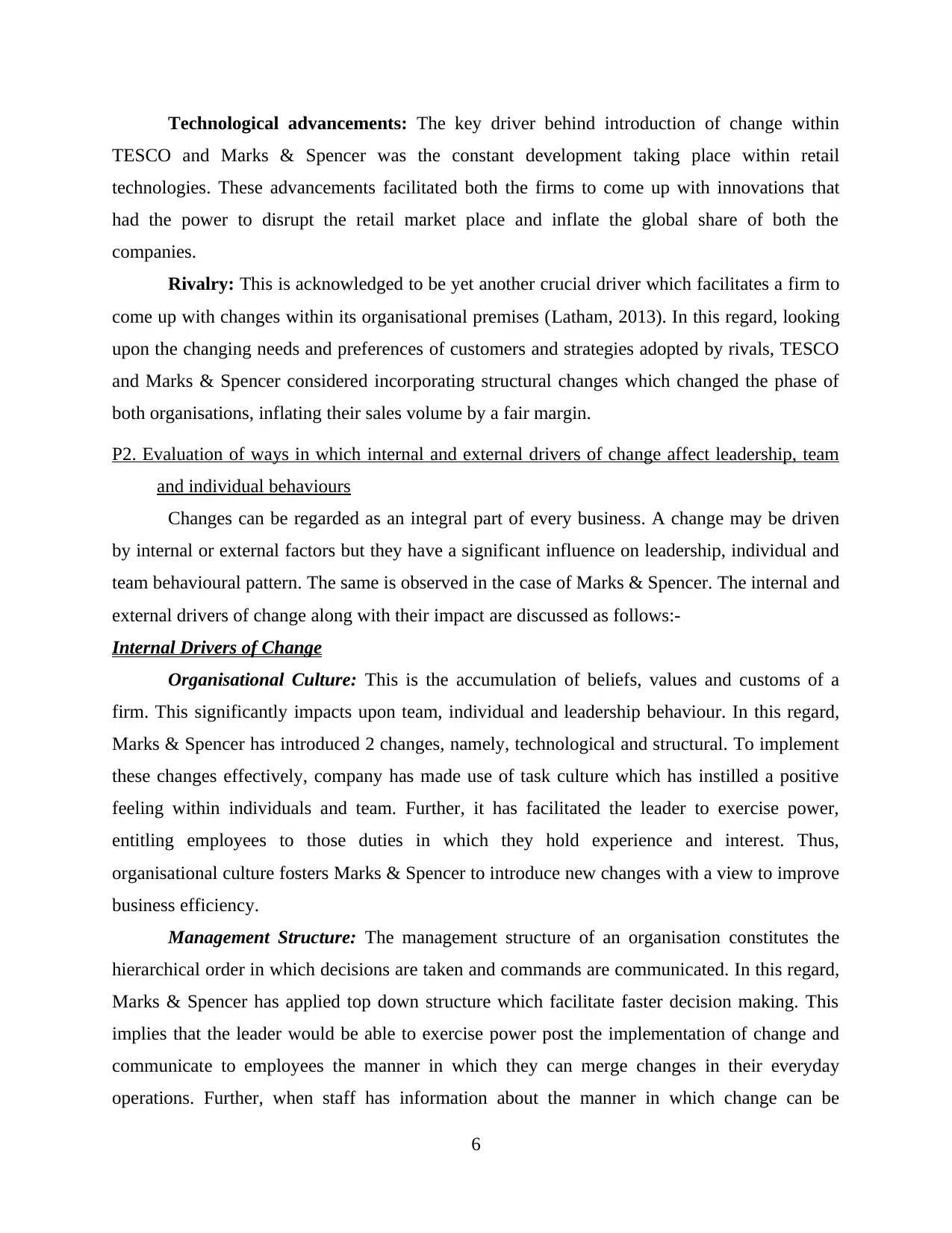
Technological advancements: The key driver behind introduction of change within
TESCO and Marks & Spencer was the constant development taking place within retail
technologies. These advancements facilitated both the firms to come up with innovations that
had the power to disrupt the retail market place and inflate the global share of both the
companies.
Rivalry: This is acknowledged to be yet another crucial driver which facilitates a firm to
come up with changes within its organisational premises (Latham, 2013). In this regard, looking
upon the changing needs and preferences of customers and strategies adopted by rivals, TESCO
and Marks & Spencer considered incorporating structural changes which changed the phase of
both organisations, inflating their sales volume by a fair margin.
P2. Evaluation of ways in which internal and external drivers of change affect leadership, team
and individual behaviours
Changes can be regarded as an integral part of every business. A change may be driven
by internal or external factors but they have a significant influence on leadership, individual and
team behavioural pattern. The same is observed in the case of Marks & Spencer. The internal and
external drivers of change along with their impact are discussed as follows:-
Internal Drivers of Change
Organisational Culture: This is the accumulation of beliefs, values and customs of a
firm. This significantly impacts upon team, individual and leadership behaviour. In this regard,
Marks & Spencer has introduced 2 changes, namely, technological and structural. To implement
these changes effectively, company has made use of task culture which has instilled a positive
feeling within individuals and team. Further, it has facilitated the leader to exercise power,
entitling employees to those duties in which they hold experience and interest. Thus,
organisational culture fosters Marks & Spencer to introduce new changes with a view to improve
business efficiency.
Management Structure: The management structure of an organisation constitutes the
hierarchical order in which decisions are taken and commands are communicated. In this regard,
Marks & Spencer has applied top down structure which facilitate faster decision making. This
implies that the leader would be able to exercise power post the implementation of change and
communicate to employees the manner in which they can merge changes in their everyday
operations. Further, when staff has information about the manner in which change can be
6
TESCO and Marks & Spencer was the constant development taking place within retail
technologies. These advancements facilitated both the firms to come up with innovations that
had the power to disrupt the retail market place and inflate the global share of both the
companies.
Rivalry: This is acknowledged to be yet another crucial driver which facilitates a firm to
come up with changes within its organisational premises (Latham, 2013). In this regard, looking
upon the changing needs and preferences of customers and strategies adopted by rivals, TESCO
and Marks & Spencer considered incorporating structural changes which changed the phase of
both organisations, inflating their sales volume by a fair margin.
P2. Evaluation of ways in which internal and external drivers of change affect leadership, team
and individual behaviours
Changes can be regarded as an integral part of every business. A change may be driven
by internal or external factors but they have a significant influence on leadership, individual and
team behavioural pattern. The same is observed in the case of Marks & Spencer. The internal and
external drivers of change along with their impact are discussed as follows:-
Internal Drivers of Change
Organisational Culture: This is the accumulation of beliefs, values and customs of a
firm. This significantly impacts upon team, individual and leadership behaviour. In this regard,
Marks & Spencer has introduced 2 changes, namely, technological and structural. To implement
these changes effectively, company has made use of task culture which has instilled a positive
feeling within individuals and team. Further, it has facilitated the leader to exercise power,
entitling employees to those duties in which they hold experience and interest. Thus,
organisational culture fosters Marks & Spencer to introduce new changes with a view to improve
business efficiency.
Management Structure: The management structure of an organisation constitutes the
hierarchical order in which decisions are taken and commands are communicated. In this regard,
Marks & Spencer has applied top down structure which facilitate faster decision making. This
implies that the leader would be able to exercise power post the implementation of change and
communicate to employees the manner in which they can merge changes in their everyday
operations. Further, when staff has information about the manner in which change can be
6
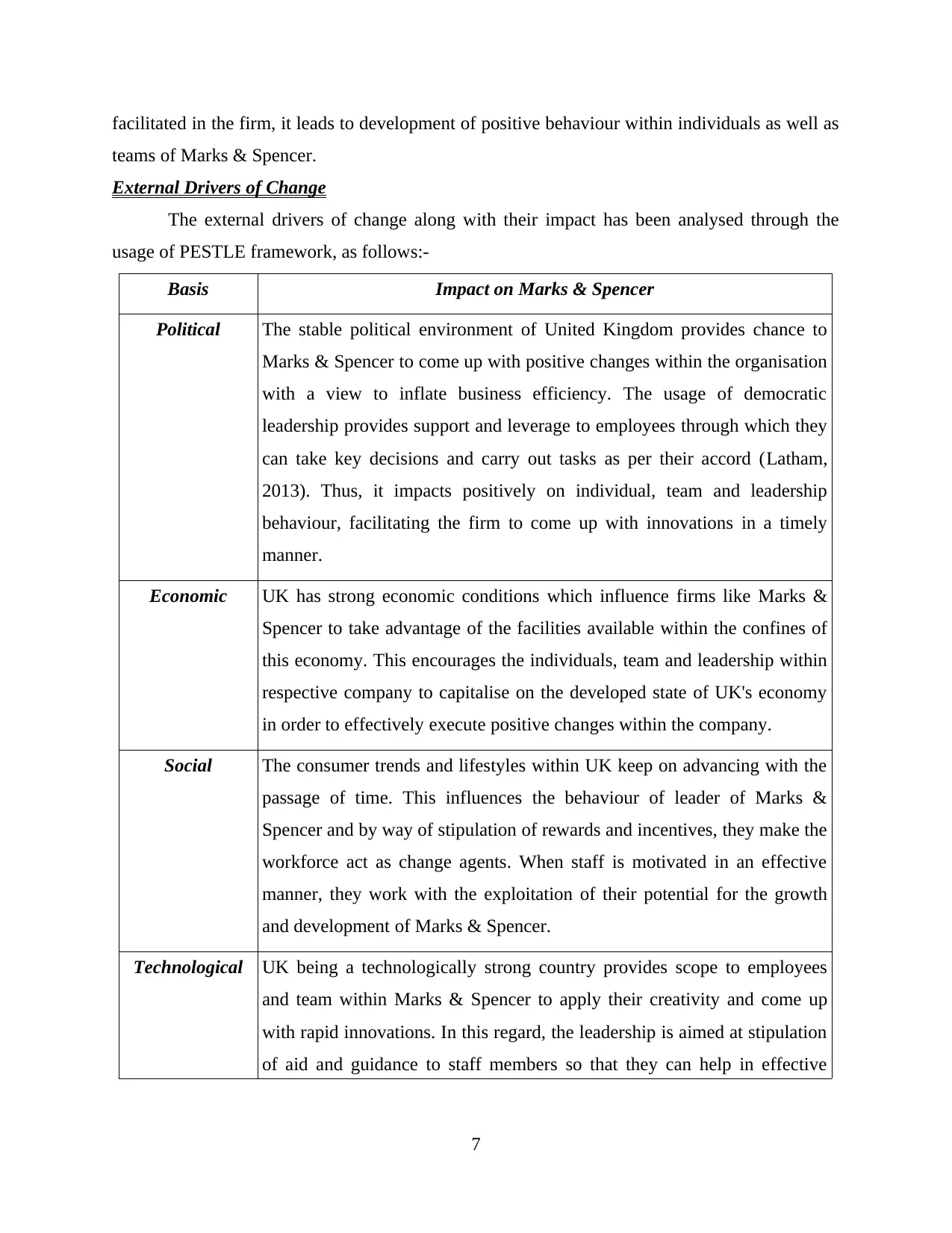
facilitated in the firm, it leads to development of positive behaviour within individuals as well as
teams of Marks & Spencer.
External Drivers of Change
The external drivers of change along with their impact has been analysed through the
usage of PESTLE framework, as follows:-
Basis Impact on Marks & Spencer
Political The stable political environment of United Kingdom provides chance to
Marks & Spencer to come up with positive changes within the organisation
with a view to inflate business efficiency. The usage of democratic
leadership provides support and leverage to employees through which they
can take key decisions and carry out tasks as per their accord (Latham,
2013). Thus, it impacts positively on individual, team and leadership
behaviour, facilitating the firm to come up with innovations in a timely
manner.
Economic UK has strong economic conditions which influence firms like Marks &
Spencer to take advantage of the facilities available within the confines of
this economy. This encourages the individuals, team and leadership within
respective company to capitalise on the developed state of UK's economy
in order to effectively execute positive changes within the company.
Social The consumer trends and lifestyles within UK keep on advancing with the
passage of time. This influences the behaviour of leader of Marks &
Spencer and by way of stipulation of rewards and incentives, they make the
workforce act as change agents. When staff is motivated in an effective
manner, they work with the exploitation of their potential for the growth
and development of Marks & Spencer.
Technological UK being a technologically strong country provides scope to employees
and team within Marks & Spencer to apply their creativity and come up
with rapid innovations. In this regard, the leadership is aimed at stipulation
of aid and guidance to staff members so that they can help in effective
7
teams of Marks & Spencer.
External Drivers of Change
The external drivers of change along with their impact has been analysed through the
usage of PESTLE framework, as follows:-
Basis Impact on Marks & Spencer
Political The stable political environment of United Kingdom provides chance to
Marks & Spencer to come up with positive changes within the organisation
with a view to inflate business efficiency. The usage of democratic
leadership provides support and leverage to employees through which they
can take key decisions and carry out tasks as per their accord (Latham,
2013). Thus, it impacts positively on individual, team and leadership
behaviour, facilitating the firm to come up with innovations in a timely
manner.
Economic UK has strong economic conditions which influence firms like Marks &
Spencer to take advantage of the facilities available within the confines of
this economy. This encourages the individuals, team and leadership within
respective company to capitalise on the developed state of UK's economy
in order to effectively execute positive changes within the company.
Social The consumer trends and lifestyles within UK keep on advancing with the
passage of time. This influences the behaviour of leader of Marks &
Spencer and by way of stipulation of rewards and incentives, they make the
workforce act as change agents. When staff is motivated in an effective
manner, they work with the exploitation of their potential for the growth
and development of Marks & Spencer.
Technological UK being a technologically strong country provides scope to employees
and team within Marks & Spencer to apply their creativity and come up
with rapid innovations. In this regard, the leadership is aimed at stipulation
of aid and guidance to staff members so that they can help in effective
7
Paraphrase This Document
Need a fresh take? Get an instant paraphrase of this document with our AI Paraphraser

implementation of positive changes within Marks & Spencer.
P3. Evaluation of measures taken minimising negative impact of changes upon organisational
behaviour
Change is quite a vital process which has both negative and positive impact on functions
and operations of an organization. Thus, it becomes necessary for all companies to make efforts
for minimizing negative impacts of change on overall organizational behaviour. Marks &
Spencer is introducing two major changes, technological and structural, within the premises. To
reduce the negative effect of these changes, the following measures are undertaken:-
Marks & Spencer should constantly conduct market research with a view to identify the
latest or future trends beforehand. This would provide aid to the entity in communicating
about such trends to employees so that when firm introduces change to exploit those
trends, employees do not resist those alterations. This would imply entailment of support
and facilitation from staff while executing a change in company’s premise (Mukherjee
and et. al., 2012).
Marks & Spencer can also arrange training sessions whereby employees would be
provided practical knowledge about the manner in which they should react and behave
when a change is introduced by the management for organisational benefit. This would
ease the chance of reducing employee resistance at the time of execution of change.
M2 Apply appropriate theories and models to critically evaluate organisational response to
change
Change being a crucial component of an enterprise brings with its implementation some
negative effects which need to be reduced in a timely manner so that the operations of entity are
not hampered to a large extent (Kotter, 2012). In this regard, Marks & Spencer is going through
two major changes i.e. technological and structural change. Thus, to reduce the negative effects
of these changes, use of PDCA model is made.
PDCA Model
It is a project management and planning tool that is used by an organization to reduce
negative the impact of any change on overall organizational behaviour and structure. PDCA
model is having four stages which facilitate a continuous improvement in a business enterprise
8
P3. Evaluation of measures taken minimising negative impact of changes upon organisational
behaviour
Change is quite a vital process which has both negative and positive impact on functions
and operations of an organization. Thus, it becomes necessary for all companies to make efforts
for minimizing negative impacts of change on overall organizational behaviour. Marks &
Spencer is introducing two major changes, technological and structural, within the premises. To
reduce the negative effect of these changes, the following measures are undertaken:-
Marks & Spencer should constantly conduct market research with a view to identify the
latest or future trends beforehand. This would provide aid to the entity in communicating
about such trends to employees so that when firm introduces change to exploit those
trends, employees do not resist those alterations. This would imply entailment of support
and facilitation from staff while executing a change in company’s premise (Mukherjee
and et. al., 2012).
Marks & Spencer can also arrange training sessions whereby employees would be
provided practical knowledge about the manner in which they should react and behave
when a change is introduced by the management for organisational benefit. This would
ease the chance of reducing employee resistance at the time of execution of change.
M2 Apply appropriate theories and models to critically evaluate organisational response to
change
Change being a crucial component of an enterprise brings with its implementation some
negative effects which need to be reduced in a timely manner so that the operations of entity are
not hampered to a large extent (Kotter, 2012). In this regard, Marks & Spencer is going through
two major changes i.e. technological and structural change. Thus, to reduce the negative effects
of these changes, use of PDCA model is made.
PDCA Model
It is a project management and planning tool that is used by an organization to reduce
negative the impact of any change on overall organizational behaviour and structure. PDCA
model is having four stages which facilitate a continuous improvement in a business enterprise
8

through effectively implementing required changes. In business market of UK cut throat
competition is prevailing and it is also very dynamic in nature which has increased issues for
Marks & Spencer thus, to cope up with these threats and to get better competitive strength,
technical and structural changes are made. Four stages of PDCA and their role in minimizing
negative impact of change in Marks & Spencer is provided below:-
Plan- It is the first step of this model where efforts are made to identify or determine the
main cause of issue or problem for which changes are needed. Use of market research is made by
Marks & Spencer to determine different drivers of force which are creating threat or opportunity
for organization (Foltin and Keller, 2012). It has been evaluated by Marks & Spencer that rapid
technical changes are going in the market and level of competition has also increased thus,
proper planning and strategy formation are needed to cope with these issue.
Do- After preparing proper plan for identified problems and opportunities the next step is
proper execution of plan which represents the Do phase of this model. Under this step, proper
technical and structural change are brought by Marks & Spencer after evaluation and proper
planning thus, it reduce the changes of wrong decision making. This phase reduce the risk of
wrong decision making thus, minimize negative impact of change.
Check- After proper planning and implementation of change the next phase of this model
includes a comparison between actual and desired performance so that a check or control can be
put on overall change. Proper use of monitoring techniques is made by Marks & Spencer to
check or evaluate performance and effectiveness of its changes which ensure reduction in
negative impact of change.
Act- This is the final step of PDCA model where documentation and reporting for change
is made all employees and other stakeholders are informed about the change (Hrebiniak, 2013).
It is the step where changes are actually put in use in a practical way thus, it provide information
about success or failure of a change. Under this process, recommendations are made and
followed by Marks & Spencer which ensure improvement in changes and also enhance
efficiency of operation, thus, negative impacts of changes are eliminated or reduced.
P4. Barriers for Change
Change is an essential process pertaining to every enterprise as it is aimed at bringing
improvements within the organisational confines by way of adoption of new technologies,
systems or techniques. Change allows an enterprise to ensure that the personnel working within
9
competition is prevailing and it is also very dynamic in nature which has increased issues for
Marks & Spencer thus, to cope up with these threats and to get better competitive strength,
technical and structural changes are made. Four stages of PDCA and their role in minimizing
negative impact of change in Marks & Spencer is provided below:-
Plan- It is the first step of this model where efforts are made to identify or determine the
main cause of issue or problem for which changes are needed. Use of market research is made by
Marks & Spencer to determine different drivers of force which are creating threat or opportunity
for organization (Foltin and Keller, 2012). It has been evaluated by Marks & Spencer that rapid
technical changes are going in the market and level of competition has also increased thus,
proper planning and strategy formation are needed to cope with these issue.
Do- After preparing proper plan for identified problems and opportunities the next step is
proper execution of plan which represents the Do phase of this model. Under this step, proper
technical and structural change are brought by Marks & Spencer after evaluation and proper
planning thus, it reduce the changes of wrong decision making. This phase reduce the risk of
wrong decision making thus, minimize negative impact of change.
Check- After proper planning and implementation of change the next phase of this model
includes a comparison between actual and desired performance so that a check or control can be
put on overall change. Proper use of monitoring techniques is made by Marks & Spencer to
check or evaluate performance and effectiveness of its changes which ensure reduction in
negative impact of change.
Act- This is the final step of PDCA model where documentation and reporting for change
is made all employees and other stakeholders are informed about the change (Hrebiniak, 2013).
It is the step where changes are actually put in use in a practical way thus, it provide information
about success or failure of a change. Under this process, recommendations are made and
followed by Marks & Spencer which ensure improvement in changes and also enhance
efficiency of operation, thus, negative impacts of changes are eliminated or reduced.
P4. Barriers for Change
Change is an essential process pertaining to every enterprise as it is aimed at bringing
improvements within the organisational confines by way of adoption of new technologies,
systems or techniques. Change allows an enterprise to ensure that the personnel working within
9
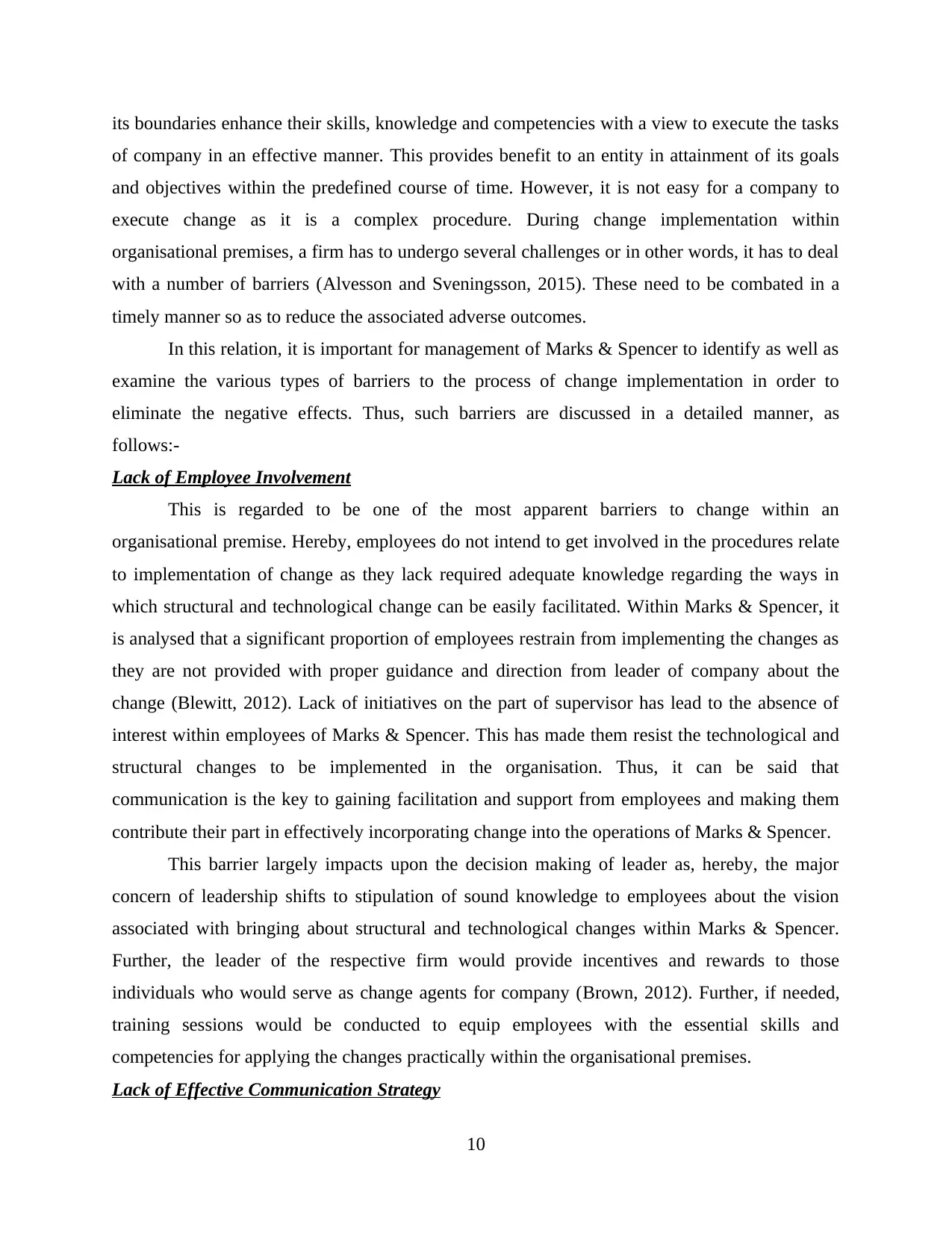
its boundaries enhance their skills, knowledge and competencies with a view to execute the tasks
of company in an effective manner. This provides benefit to an entity in attainment of its goals
and objectives within the predefined course of time. However, it is not easy for a company to
execute change as it is a complex procedure. During change implementation within
organisational premises, a firm has to undergo several challenges or in other words, it has to deal
with a number of barriers (Alvesson and Sveningsson, 2015). These need to be combated in a
timely manner so as to reduce the associated adverse outcomes.
In this relation, it is important for management of Marks & Spencer to identify as well as
examine the various types of barriers to the process of change implementation in order to
eliminate the negative effects. Thus, such barriers are discussed in a detailed manner, as
follows:-
Lack of Employee Involvement
This is regarded to be one of the most apparent barriers to change within an
organisational premise. Hereby, employees do not intend to get involved in the procedures relate
to implementation of change as they lack required adequate knowledge regarding the ways in
which structural and technological change can be easily facilitated. Within Marks & Spencer, it
is analysed that a significant proportion of employees restrain from implementing the changes as
they are not provided with proper guidance and direction from leader of company about the
change (Blewitt, 2012). Lack of initiatives on the part of supervisor has lead to the absence of
interest within employees of Marks & Spencer. This has made them resist the technological and
structural changes to be implemented in the organisation. Thus, it can be said that
communication is the key to gaining facilitation and support from employees and making them
contribute their part in effectively incorporating change into the operations of Marks & Spencer.
This barrier largely impacts upon the decision making of leader as, hereby, the major
concern of leadership shifts to stipulation of sound knowledge to employees about the vision
associated with bringing about structural and technological changes within Marks & Spencer.
Further, the leader of the respective firm would provide incentives and rewards to those
individuals who would serve as change agents for company (Brown, 2012). Further, if needed,
training sessions would be conducted to equip employees with the essential skills and
competencies for applying the changes practically within the organisational premises.
Lack of Effective Communication Strategy
10
of company in an effective manner. This provides benefit to an entity in attainment of its goals
and objectives within the predefined course of time. However, it is not easy for a company to
execute change as it is a complex procedure. During change implementation within
organisational premises, a firm has to undergo several challenges or in other words, it has to deal
with a number of barriers (Alvesson and Sveningsson, 2015). These need to be combated in a
timely manner so as to reduce the associated adverse outcomes.
In this relation, it is important for management of Marks & Spencer to identify as well as
examine the various types of barriers to the process of change implementation in order to
eliminate the negative effects. Thus, such barriers are discussed in a detailed manner, as
follows:-
Lack of Employee Involvement
This is regarded to be one of the most apparent barriers to change within an
organisational premise. Hereby, employees do not intend to get involved in the procedures relate
to implementation of change as they lack required adequate knowledge regarding the ways in
which structural and technological change can be easily facilitated. Within Marks & Spencer, it
is analysed that a significant proportion of employees restrain from implementing the changes as
they are not provided with proper guidance and direction from leader of company about the
change (Blewitt, 2012). Lack of initiatives on the part of supervisor has lead to the absence of
interest within employees of Marks & Spencer. This has made them resist the technological and
structural changes to be implemented in the organisation. Thus, it can be said that
communication is the key to gaining facilitation and support from employees and making them
contribute their part in effectively incorporating change into the operations of Marks & Spencer.
This barrier largely impacts upon the decision making of leader as, hereby, the major
concern of leadership shifts to stipulation of sound knowledge to employees about the vision
associated with bringing about structural and technological changes within Marks & Spencer.
Further, the leader of the respective firm would provide incentives and rewards to those
individuals who would serve as change agents for company (Brown, 2012). Further, if needed,
training sessions would be conducted to equip employees with the essential skills and
competencies for applying the changes practically within the organisational premises.
Lack of Effective Communication Strategy
10
Secure Best Marks with AI Grader
Need help grading? Try our AI Grader for instant feedback on your assignments.

This is regarded to be yet another crucial barrier that is encountered by a firm while
executing changes within the organisational premises. In this regard, an effective communication
strategy is considered to be the route map through which the leader of firm communicates the
benefits of bringing change within company to employees, so that they can provide support to
leadership in successful implementation of change. In relation to Marks & Spencer, it has been
analysed that the leader of this company could not adopt a strong communication strategy to
transmit the vision of changes to personnel so that they provide support in implementation of
new technologies and organisational structure. It is seen that whereby the management is unable
to set an interaction with employees, personnel are not much interested in accepting the changes
and incorporating them into their day to day operations.
This barrier has a substantial impact on leadership decision making within Marks &
Spencer as, hereby, the leader now makes use of an effective communication medium and
strategy through which necessary information is communicated to employees. Further, the
benefits of bringing new technology and facilitating new structure would be transmitted to the
staff members (Doppelt, 2017). When personnel would understand the benefits of adopting
changes, they would provide support to the management in implementing the same in a rapid
manner.
Thus, in the above mentioned ways, barriers to change have a significant impact on
decision making of leader related to implementation of structural and technological changes
within Marks & Spencer. As a result, the decision of leader may get delayed or postponed.
M3. Force field analysis
Force field analysis is a key approach for studying change management. It involves
facilitating and restraining factors of change which are explained below:-
Facilitating Factors: They encourage change adoption within an enterprise. Such factors
may include outdated business processes and systems, decline in team morale, customers,
changes in needs and preferences of customers, technological advancements. In this regard, the
facilitating factors for Marks & Spencer were emerging technological trends in retail sector and
business complexities.
Restraining Factors: They hinder changes from being adopted within an entity. Such
factors comprise of resistance from staff, governmental laws, ineffective communication etc. In
context of Marks & Spencer, the restraining factors were excessive employee resistance and
11
executing changes within the organisational premises. In this regard, an effective communication
strategy is considered to be the route map through which the leader of firm communicates the
benefits of bringing change within company to employees, so that they can provide support to
leadership in successful implementation of change. In relation to Marks & Spencer, it has been
analysed that the leader of this company could not adopt a strong communication strategy to
transmit the vision of changes to personnel so that they provide support in implementation of
new technologies and organisational structure. It is seen that whereby the management is unable
to set an interaction with employees, personnel are not much interested in accepting the changes
and incorporating them into their day to day operations.
This barrier has a substantial impact on leadership decision making within Marks &
Spencer as, hereby, the leader now makes use of an effective communication medium and
strategy through which necessary information is communicated to employees. Further, the
benefits of bringing new technology and facilitating new structure would be transmitted to the
staff members (Doppelt, 2017). When personnel would understand the benefits of adopting
changes, they would provide support to the management in implementing the same in a rapid
manner.
Thus, in the above mentioned ways, barriers to change have a significant impact on
decision making of leader related to implementation of structural and technological changes
within Marks & Spencer. As a result, the decision of leader may get delayed or postponed.
M3. Force field analysis
Force field analysis is a key approach for studying change management. It involves
facilitating and restraining factors of change which are explained below:-
Facilitating Factors: They encourage change adoption within an enterprise. Such factors
may include outdated business processes and systems, decline in team morale, customers,
changes in needs and preferences of customers, technological advancements. In this regard, the
facilitating factors for Marks & Spencer were emerging technological trends in retail sector and
business complexities.
Restraining Factors: They hinder changes from being adopted within an entity. Such
factors comprise of resistance from staff, governmental laws, ineffective communication etc. In
context of Marks & Spencer, the restraining factors were excessive employee resistance and
11
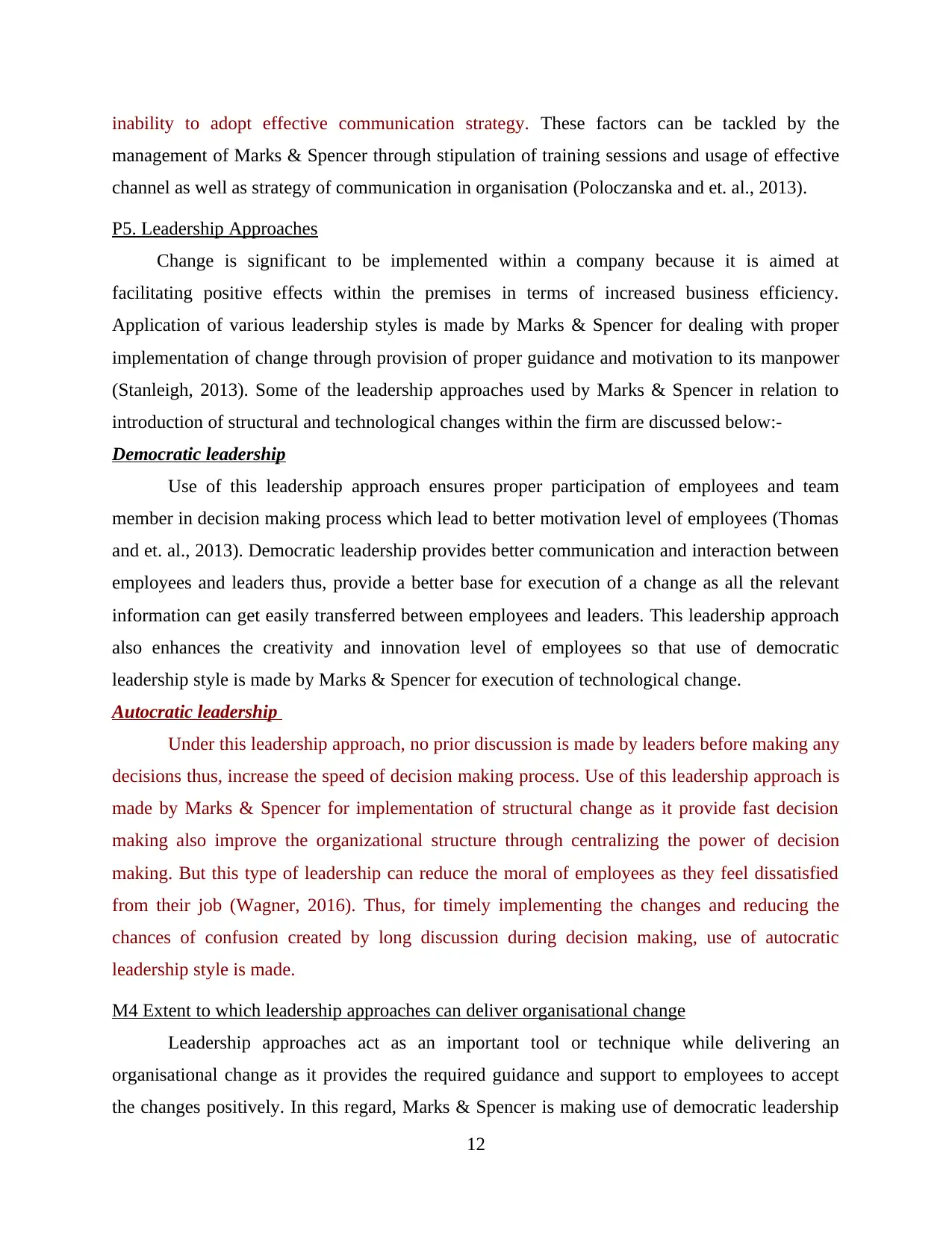
inability to adopt effective communication strategy. These factors can be tackled by the
management of Marks & Spencer through stipulation of training sessions and usage of effective
channel as well as strategy of communication in organisation (Poloczanska and et. al., 2013).
P5. Leadership Approaches
Change is significant to be implemented within a company because it is aimed at
facilitating positive effects within the premises in terms of increased business efficiency.
Application of various leadership styles is made by Marks & Spencer for dealing with proper
implementation of change through provision of proper guidance and motivation to its manpower
(Stanleigh, 2013). Some of the leadership approaches used by Marks & Spencer in relation to
introduction of structural and technological changes within the firm are discussed below:-
Democratic leadership
Use of this leadership approach ensures proper participation of employees and team
member in decision making process which lead to better motivation level of employees (Thomas
and et. al., 2013). Democratic leadership provides better communication and interaction between
employees and leaders thus, provide a better base for execution of a change as all the relevant
information can get easily transferred between employees and leaders. This leadership approach
also enhances the creativity and innovation level of employees so that use of democratic
leadership style is made by Marks & Spencer for execution of technological change.
Autocratic leadership
Under this leadership approach, no prior discussion is made by leaders before making any
decisions thus, increase the speed of decision making process. Use of this leadership approach is
made by Marks & Spencer for implementation of structural change as it provide fast decision
making also improve the organizational structure through centralizing the power of decision
making. But this type of leadership can reduce the moral of employees as they feel dissatisfied
from their job (Wagner, 2016). Thus, for timely implementing the changes and reducing the
chances of confusion created by long discussion during decision making, use of autocratic
leadership style is made.
M4 Extent to which leadership approaches can deliver organisational change
Leadership approaches act as an important tool or technique while delivering an
organisational change as it provides the required guidance and support to employees to accept
the changes positively. In this regard, Marks & Spencer is making use of democratic leadership
12
management of Marks & Spencer through stipulation of training sessions and usage of effective
channel as well as strategy of communication in organisation (Poloczanska and et. al., 2013).
P5. Leadership Approaches
Change is significant to be implemented within a company because it is aimed at
facilitating positive effects within the premises in terms of increased business efficiency.
Application of various leadership styles is made by Marks & Spencer for dealing with proper
implementation of change through provision of proper guidance and motivation to its manpower
(Stanleigh, 2013). Some of the leadership approaches used by Marks & Spencer in relation to
introduction of structural and technological changes within the firm are discussed below:-
Democratic leadership
Use of this leadership approach ensures proper participation of employees and team
member in decision making process which lead to better motivation level of employees (Thomas
and et. al., 2013). Democratic leadership provides better communication and interaction between
employees and leaders thus, provide a better base for execution of a change as all the relevant
information can get easily transferred between employees and leaders. This leadership approach
also enhances the creativity and innovation level of employees so that use of democratic
leadership style is made by Marks & Spencer for execution of technological change.
Autocratic leadership
Under this leadership approach, no prior discussion is made by leaders before making any
decisions thus, increase the speed of decision making process. Use of this leadership approach is
made by Marks & Spencer for implementation of structural change as it provide fast decision
making also improve the organizational structure through centralizing the power of decision
making. But this type of leadership can reduce the moral of employees as they feel dissatisfied
from their job (Wagner, 2016). Thus, for timely implementing the changes and reducing the
chances of confusion created by long discussion during decision making, use of autocratic
leadership style is made.
M4 Extent to which leadership approaches can deliver organisational change
Leadership approaches act as an important tool or technique while delivering an
organisational change as it provides the required guidance and support to employees to accept
the changes positively. In this regard, Marks & Spencer is making use of democratic leadership
12
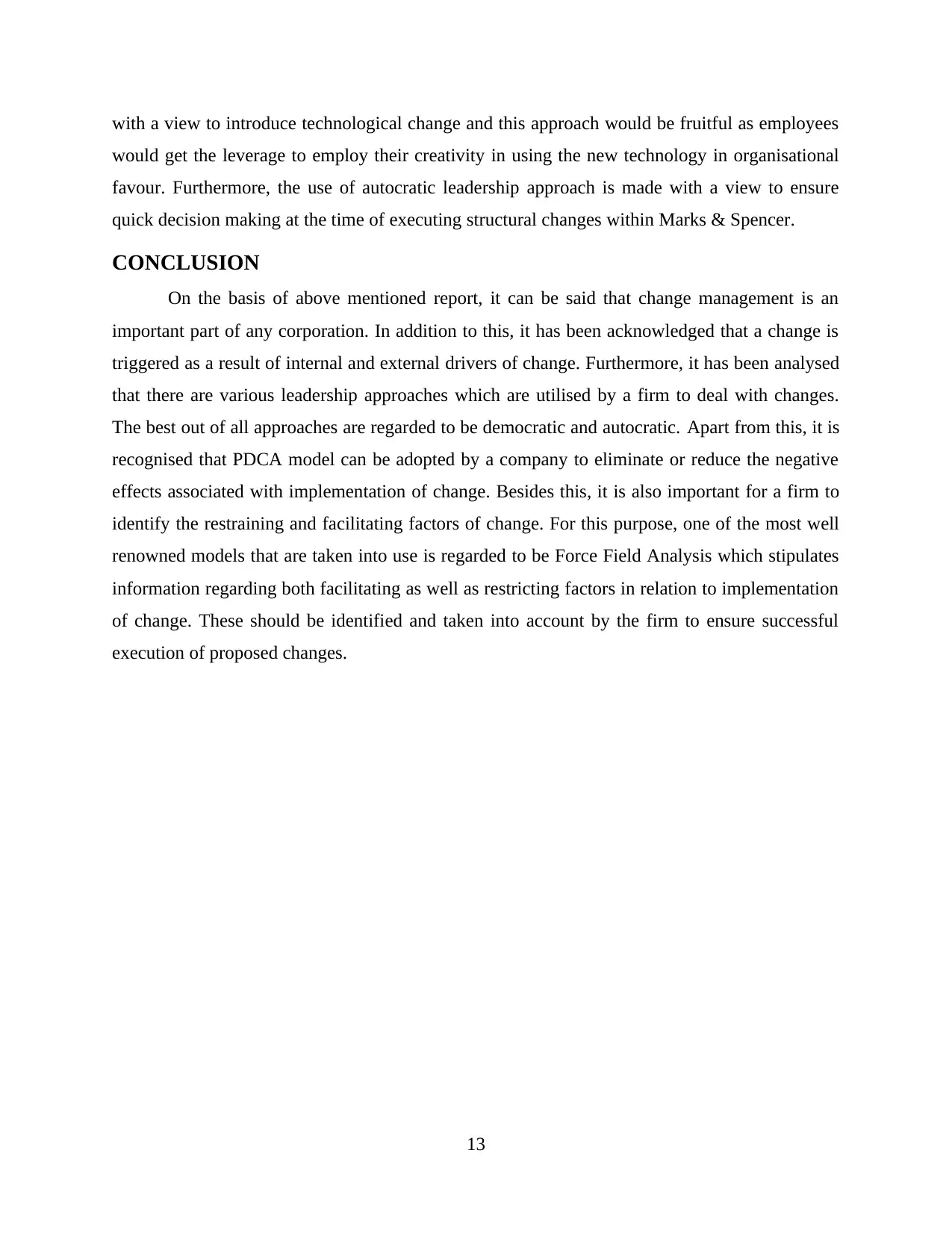
with a view to introduce technological change and this approach would be fruitful as employees
would get the leverage to employ their creativity in using the new technology in organisational
favour. Furthermore, the use of autocratic leadership approach is made with a view to ensure
quick decision making at the time of executing structural changes within Marks & Spencer.
CONCLUSION
On the basis of above mentioned report, it can be said that change management is an
important part of any corporation. In addition to this, it has been acknowledged that a change is
triggered as a result of internal and external drivers of change. Furthermore, it has been analysed
that there are various leadership approaches which are utilised by a firm to deal with changes.
The best out of all approaches are regarded to be democratic and autocratic. Apart from this, it is
recognised that PDCA model can be adopted by a company to eliminate or reduce the negative
effects associated with implementation of change. Besides this, it is also important for a firm to
identify the restraining and facilitating factors of change. For this purpose, one of the most well
renowned models that are taken into use is regarded to be Force Field Analysis which stipulates
information regarding both facilitating as well as restricting factors in relation to implementation
of change. These should be identified and taken into account by the firm to ensure successful
execution of proposed changes.
13
would get the leverage to employ their creativity in using the new technology in organisational
favour. Furthermore, the use of autocratic leadership approach is made with a view to ensure
quick decision making at the time of executing structural changes within Marks & Spencer.
CONCLUSION
On the basis of above mentioned report, it can be said that change management is an
important part of any corporation. In addition to this, it has been acknowledged that a change is
triggered as a result of internal and external drivers of change. Furthermore, it has been analysed
that there are various leadership approaches which are utilised by a firm to deal with changes.
The best out of all approaches are regarded to be democratic and autocratic. Apart from this, it is
recognised that PDCA model can be adopted by a company to eliminate or reduce the negative
effects associated with implementation of change. Besides this, it is also important for a firm to
identify the restraining and facilitating factors of change. For this purpose, one of the most well
renowned models that are taken into use is regarded to be Force Field Analysis which stipulates
information regarding both facilitating as well as restricting factors in relation to implementation
of change. These should be identified and taken into account by the firm to ensure successful
execution of proposed changes.
13
Paraphrase This Document
Need a fresh take? Get an instant paraphrase of this document with our AI Paraphraser
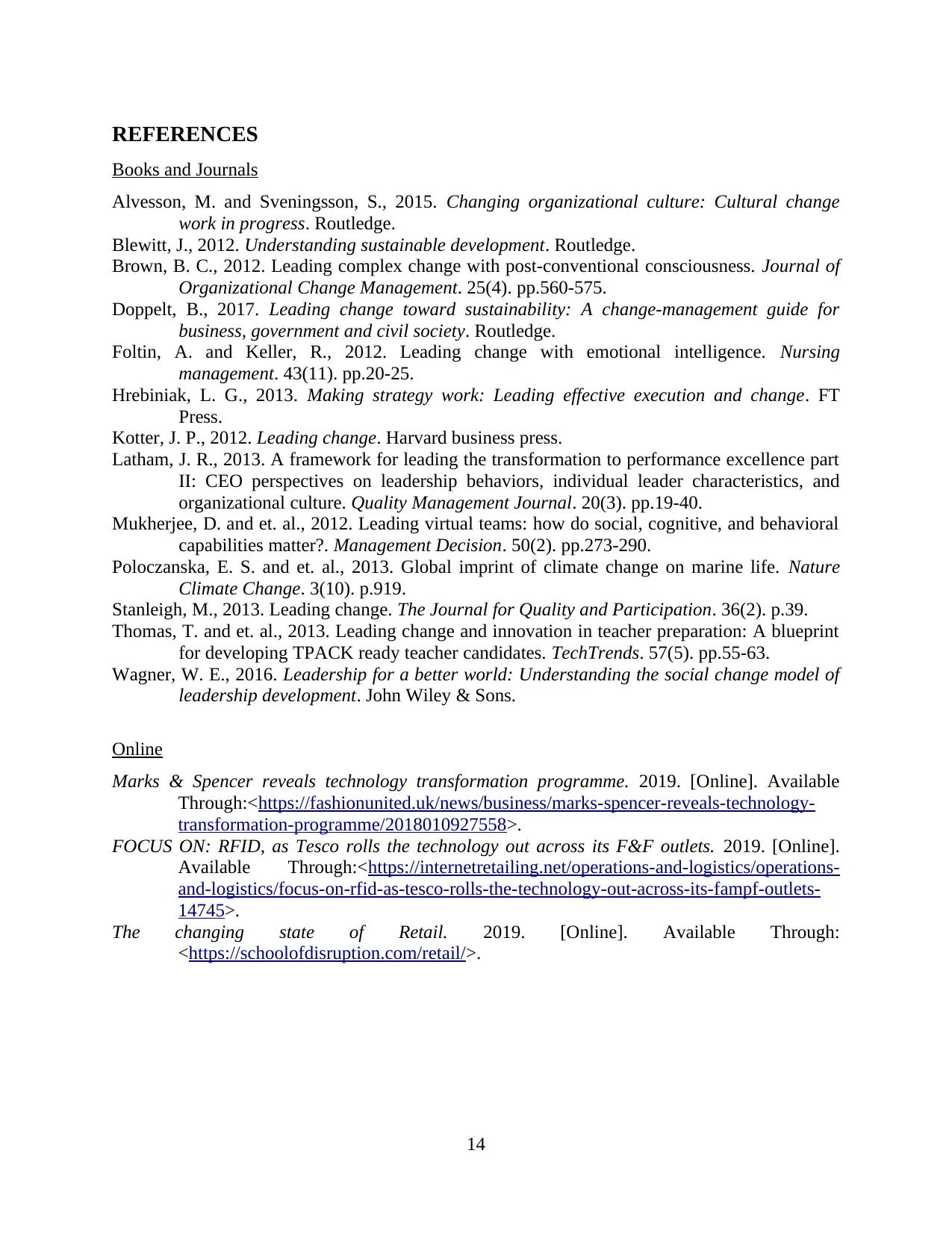
REFERENCES
Books and Journals
Alvesson, M. and Sveningsson, S., 2015. Changing organizational culture: Cultural change
work in progress. Routledge.
Blewitt, J., 2012. Understanding sustainable development. Routledge.
Brown, B. C., 2012. Leading complex change with post-conventional consciousness. Journal of
Organizational Change Management. 25(4). pp.560-575.
Doppelt, B., 2017. Leading change toward sustainability: A change-management guide for
business, government and civil society. Routledge.
Foltin, A. and Keller, R., 2012. Leading change with emotional intelligence. Nursing
management. 43(11). pp.20-25.
Hrebiniak, L. G., 2013. Making strategy work: Leading effective execution and change. FT
Press.
Kotter, J. P., 2012. Leading change. Harvard business press.
Latham, J. R., 2013. A framework for leading the transformation to performance excellence part
II: CEO perspectives on leadership behaviors, individual leader characteristics, and
organizational culture. Quality Management Journal. 20(3). pp.19-40.
Mukherjee, D. and et. al., 2012. Leading virtual teams: how do social, cognitive, and behavioral
capabilities matter?. Management Decision. 50(2). pp.273-290.
Poloczanska, E. S. and et. al., 2013. Global imprint of climate change on marine life. Nature
Climate Change. 3(10). p.919.
Stanleigh, M., 2013. Leading change. The Journal for Quality and Participation. 36(2). p.39.
Thomas, T. and et. al., 2013. Leading change and innovation in teacher preparation: A blueprint
for developing TPACK ready teacher candidates. TechTrends. 57(5). pp.55-63.
Wagner, W. E., 2016. Leadership for a better world: Understanding the social change model of
leadership development. John Wiley & Sons.
Online
Marks & Spencer reveals technology transformation programme. 2019. [Online]. Available
Through:<https://fashionunited.uk/news/business/marks-spencer-reveals-technology-
transformation-programme/2018010927558>.
FOCUS ON: RFID, as Tesco rolls the technology out across its F&F outlets. 2019. [Online].
Available Through:<https://internetretailing.net/operations-and-logistics/operations-
and-logistics/focus-on-rfid-as-tesco-rolls-the-technology-out-across-its-fampf-outlets-
14745>.
The changing state of Retail. 2019. [Online]. Available Through:
<https://schoolofdisruption.com/retail/>.
14
Books and Journals
Alvesson, M. and Sveningsson, S., 2015. Changing organizational culture: Cultural change
work in progress. Routledge.
Blewitt, J., 2012. Understanding sustainable development. Routledge.
Brown, B. C., 2012. Leading complex change with post-conventional consciousness. Journal of
Organizational Change Management. 25(4). pp.560-575.
Doppelt, B., 2017. Leading change toward sustainability: A change-management guide for
business, government and civil society. Routledge.
Foltin, A. and Keller, R., 2012. Leading change with emotional intelligence. Nursing
management. 43(11). pp.20-25.
Hrebiniak, L. G., 2013. Making strategy work: Leading effective execution and change. FT
Press.
Kotter, J. P., 2012. Leading change. Harvard business press.
Latham, J. R., 2013. A framework for leading the transformation to performance excellence part
II: CEO perspectives on leadership behaviors, individual leader characteristics, and
organizational culture. Quality Management Journal. 20(3). pp.19-40.
Mukherjee, D. and et. al., 2012. Leading virtual teams: how do social, cognitive, and behavioral
capabilities matter?. Management Decision. 50(2). pp.273-290.
Poloczanska, E. S. and et. al., 2013. Global imprint of climate change on marine life. Nature
Climate Change. 3(10). p.919.
Stanleigh, M., 2013. Leading change. The Journal for Quality and Participation. 36(2). p.39.
Thomas, T. and et. al., 2013. Leading change and innovation in teacher preparation: A blueprint
for developing TPACK ready teacher candidates. TechTrends. 57(5). pp.55-63.
Wagner, W. E., 2016. Leadership for a better world: Understanding the social change model of
leadership development. John Wiley & Sons.
Online
Marks & Spencer reveals technology transformation programme. 2019. [Online]. Available
Through:<https://fashionunited.uk/news/business/marks-spencer-reveals-technology-
transformation-programme/2018010927558>.
FOCUS ON: RFID, as Tesco rolls the technology out across its F&F outlets. 2019. [Online].
Available Through:<https://internetretailing.net/operations-and-logistics/operations-
and-logistics/focus-on-rfid-as-tesco-rolls-the-technology-out-across-its-fampf-outlets-
14745>.
The changing state of Retail. 2019. [Online]. Available Through:
<https://schoolofdisruption.com/retail/>.
14
1 out of 14
Related Documents
Your All-in-One AI-Powered Toolkit for Academic Success.
+13062052269
info@desklib.com
Available 24*7 on WhatsApp / Email
![[object Object]](/_next/static/media/star-bottom.7253800d.svg)
Unlock your academic potential
© 2024 | Zucol Services PVT LTD | All rights reserved.





